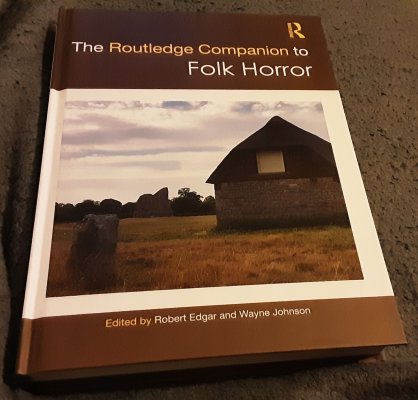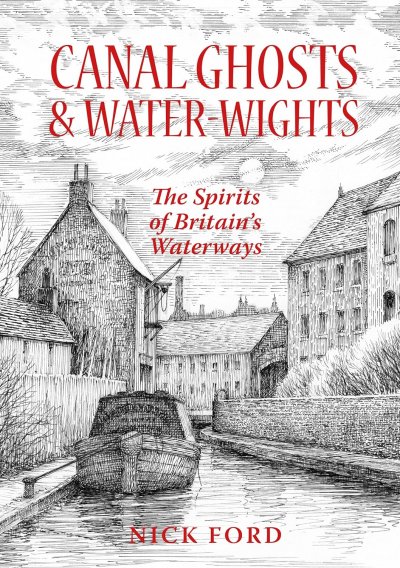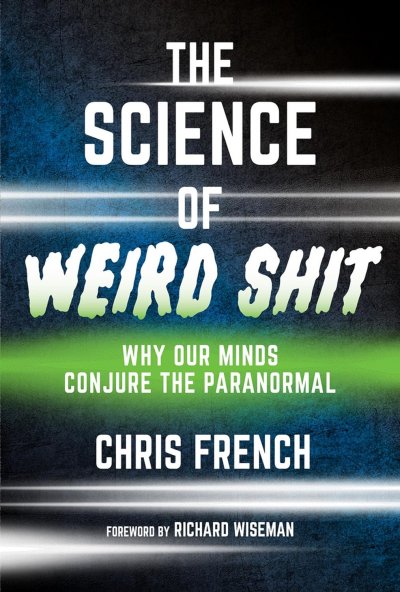Mythopoeika
I am a meat popsicle
- Joined
- Sep 18, 2001
- Messages
- 51,831
- Location
- Inside a starship, watching puny humans from afar
The bank account details.drop me a PM with the details?
The bank account details.drop me a PM with the details?
Is this a medieval statue? I ask because, to me, it looks more victorian - even if it comes from somewhere that didn't have a victoria!
Can anyone ID it?
And this is what a copy looks like in its new home...I'm not sure what's going on with the price. £205.00 is absurd even for a (non-technical) academic publication. I expect to see it change.
View attachment 70100
View attachment 70103
The Routledge Companion to Folk Horror offers a comprehensive guide to this popular genre. It explores its origins, canonical texts and thinkers, the crucial underlying themes of nostalgia and hauntology, and identifies new trends in the field.
Divided into five parts, the first focuses on the history of Folk Horror from medieval texts to the present day. It considers the first wave of contemporary Folk Horror through the films of the ‘unholy trinity’, as well as discussing the influence of ancient gods and early Folk Horror. Part 2 looks at the spaces, landscapes, and cultural relics, which form a central focus for Folk Horror. In Part 3, the contributors examine the rich history of the use of folklore in children’s fiction. The next part discusses recent examples of Folk Horror-infused music and image. Chapters consider the relationship between different genres of music to Folk Horror (such as folk music, black metal, and new wave), sound and performance, comic books, and the Dark Web. Often regarded as British in origin, the final part analyses texts which break this link, as the contributors reveal the larger realms of regional, national, international, and transnational Folk Horror.
Featuring 40 contributions, this authoritative collection brings together leading voices in the field. It is an invaluable resource for students and scholars interested in this vibrant genre and its enduring influence on literature, film, music, and culture.
Source:
- Publisher : Routledge; 1st edition (9 Oct. 2023)
- Language : English
- Hardcover : 454 pages
- ISBN-10 : 1032042834
- ISBN-13 : 978-1032042831
- Dimensions : 16.99 x 2.69 x 24.41 cm
https://www.amazon.co.uk/Routledge-Companion-Horror-Literature-Companions/dp/1032042834

It's now on sale with 20% off. Still means it's £160 though.And this is what a copy looks like in its new home...
View attachment 72985
And no, I did not pay the quoted price for it. It does look nice but... we shall see.
I haven't read the book, and probably won't. I see the Morris as more of a modern traditional activity and less of an historical study.Suffragettes and Morris Dancing! Who knew? @Mikefule I expect!
https://www.pen-and-sword.co.uk/Mar...tes-Who-Saved-Morris-Dancing-Hardback/p/24567
This did not get a good review. I trust Justin's comments here. https://aiptcomics.com/2024/02/24/bigfoot-to-mothman-cryptid-encyclopedia/View attachment 71448
Bigfoot to Mothman: A Global Encyclopedia of Legendary Beasts and Monsters
Margo DeMello
Bloomsbury Publishing USA, Jan 25, 2024 - Social Science - 320 pages
This one-volume encyclopedia introduces readers to the world's cryptids-those hidden or secret animals believed to exist at the margins of human society-including Bigfoot, Yeti, the Loch Ness Monster, and the Mothman.
Comprehensive in its scope, this book is a valuable resource for anyone who wants to know more about well-known creatures of myth and legend, such as the Chupacabra and the Jersey Devil, and discover lesser-known animals, such as the Bunyip of Australia and the Mamlambo of South Africa. Rather than purport to prove or deny the existence of these creatures, however, this volume classifies them within their respective cultural, historical, and social contexts, allowing readers to appreciate cryptids as cultural artifacts important to societies around the globe. Finally, this book goes beyond the study of the unknown to investigate who believes in cryptids, why they do, and why the study of cryptozoology is as much about understanding cryptids as it is about understanding ourselves.

| Author | Nick Ford |
|---|---|
| Illustrator | Jeremy Ford |
| Pages | 238 |
| Dimensions | 148mm X 210mm |
| Publisher | Country Books |
"A well constructed guide with just the right mix of realism, history and paranormal activity, which is relayed using a refreshingly pragmatic approach. This book is a must if thinking about taking a boating holiday on the UK's many canals and waterways. Well researched with details of ancient inns and other establishments of interest along the way. A thoroughly enjoyable and enlightening read!"
I've never really considered canal ghosts before for some reason.As an addendum to the above, the author reads extracts from his book here:
https://spiral-books.com/author-page/nick-ford/
I've just ordered a copy; will comment when it reaches me.
I've never really considered canal ghosts before for some reason.
Yes, definitely all valid reasons.Three things that come to mind that spark my interest:
a) I've read about loss of life in canal tunnels and lock accidents, and traumatic death is often said to generate ghosts.
b) Waterways generated their own independent cultures with habits, lexicon and superstitions unknown to those without. All close-knit communities that form 'little worlds within worlds' seem to feature distinct rituals related to the living and the dead.
c) I see the canals as a forerunners to railways, and for me there are few settings as ghost-friendly as railways.
d) There's a memorable Inspector Morse novel that features a historical canal mystery and it sticks in my mind:
https://en.m.wikipedia.org/wiki/The_Wench_Is_Dead
I used to know a woman who was from a family of bargees. She was writing her family story - there were some fascinating tales, most of them unparanormal though.Three things that come to mind that spark my interest:
a) I've read about loss of life in canal tunnels and lock accidents, and traumatic death is often said to generate ghosts.
b) Waterways generated their own independent cultures with habits, lexicon and superstitions unknown to those without. All close-knit communities that form 'little worlds within worlds' seem to feature distinct rituals related to the living and the dead.
c) I see the canals as a forerunners to railways, and for me there are few settings as ghost-friendly as railways.
d) There's a memorable Inspector Morse novel that features a historical canal mystery and it sticks in my mind:
https://en.m.wikipedia.org/wiki/The_Wench_Is_Dead
A woman who lives here has written a couple of books about her Grandmother's life on the canal;I used to know a woman who was from a family of bargees. She was writing her family story - there were some fascinating tales, most of them unparanormal though.
As an addendum to the above, the author reads extracts from his book here:
https://spiral-books.com/author-page/nick-ford/
I've just ordered a copy; will comment when it reaches me.
Professor Chris French's new book "The Science of Weird Shit" is released in a few days time. I'm a little surprised the vulgar title was agreed upon! I've put links to the UK and US Amazon stores below:
UK:
https://amzn.to/3TCMqoc
US:
https://amzn.to/43rFYnp

I wonder what brief was given to the cover artist? If it was just the title, God knows what they could have come up with. "Mr Hankey, the Christmas poo." springs to mind.The publisher also made no effort with the cover.
I am not exaggerating when I say this is the sort of quality you can achieve on your lunch break.
View attachment 74802

That entire description of Mallory just made me think ADHD.View attachment 76098
'Mick Conefrey's Fallen is a marvellously researched and written story about the enigma of George Mallory and the fulfilment of his "Because it's there!"' Peter Hillary
- Publisher : Allen & Unwin; Main edition (2 May 2024)
- Language : English
- Hardcover : 352 pages
- ISBN-10 : 1838959793
- ISBN-13 : 978-1838959791
- Dimensions : 16 x 3 x 24.2 cm
On 6 June, 1924 George Mallory donned an oxygen set and set off for the summit of Everest with his young partner Andrew Irvine. Two days later they were glimpsed through clouds heading upwards, but after that they were never seen again. Whether they died on the way up or on the way down no one knows.
In the years following his disappearance, Mallory was elevated into an all-British hero. Dubbed by his friends the 'Galahad' of Everest, he was lionised in the press as the greatest mountaineer of his generation who had died while taking on the ultimate challenge. Handsome, charismatic, daring, he was a skilled public speaker, an athletic and technically gifted climber, a committed Socialist and a supremely attractive figure to both men and women.
His friends ranged from the gay artists and writers of the Bloomsbury group to the best mountaineers of his era. But that was only one side to him. Mallory was also a risk taker who according to his friend and biographer David Pye, could never get behind the wheel of a car without overtaking the vehicle in front, a climber who pushed himself and those around him to the limits, a chaotic technophobe who was forever losing equipment or mishandling it, the man who led his porters to their deaths in 1922 and his young partner to his uncertain end in 1924.
So who was the real Mallory and what were the forces that made him and ultimately destroyed him? Why did the man who denounced oxygen sets as 'damnable heresy' in 1922 perish on an oxygen-powered summit attempt two years later? And above all, what made him go back to Everest for the third time?
Based on diaries, letters, memoirs and thousands of contemporary documents, Fallen is both a forensic account of Mallory's last expedition to Everest in 1924 and an attempt to get under his skin and separate the man from the myth.
About the Author
Mick Conefrey is an award-winning writer and documentary maker. He made the landmark BBC series Mountain Men and Icemen and The Race for Everest to mark the 60th anniversary of the first ascent. His previous books include Everest 1922, Everest 1953, the winner of a LeggiMontagna award, The Last Great Mountain, the winner of the Premio Itas in 2023, and The Ghosts of K2, which won a US National Outdoor Book award in 2017.
Source:
Amazon Preorder
